INTRODUCTION
Although the introduction of dopamine agonists in the management of acromegaly has opened new doors for a non-invasive approach to this clinical problem, this therapy has not proved wholly satisfactory. Long-term treatment with such compounds has resulted in normalization of levels of plasma growth hormone in about 30 percent of patients.1ŌĆō5) The short half-life of natural somatostatin, as well as the rebound hypersecretion of growth hormone that occurs after its infusion, has rendered the native peptide impractical for therapeutic use.6)
The long-acting somatostatin analogue, SMS 201-995, (Sandoz, Basel, Switzerland) recently became available for clinical use. This peptide exerts a strong and prolonged inhibitory effect on growth hormone release without producing rebound hypersecretion as does the natural form. In application to acromegalics, a large population of these patients had effects of growth hormone release, but a subcutaneous dose of 50 ╬╝g had suppressed growth hormone release in the acromegalics for about 8 hours.8,9)
Kinetic studies10) with SMS 201-995 have shown that the plasma half-lives for intravenous and subcutaneous injection of the agent are 43 and 113 minutes, respectively. Plewe et al8) reported a fall in plasma growth hormone concentrations to normal or nearly normal levels that lasted for nine hours in a group of subjects with acromegaly who received a single subcutaneous injection of 50 ╬╝g.
Treatment of acromegaly with dopamine agonists can reduce the size of some somatotrophic-cell adenomas, but this is considered to occur rarely in comparison with the frequent shrinkage of pituitary prolactinomas treated with these agents.11)
Human GH (hGH) is now recognized as a heterogeneous family of proteins, consisting of several molecular forms (isohormones). The predominant form of hGH present in plasma was 22K, which accounted for approximately 85% of all immunoreactive hGH, and up to approximately 7% of minor forms showed 20K. The remainder (5 to 10%) were acidic GH and acetylated. This abnormal form of hGH might be a member of a group of pathogenetic controls.12,13)
The treatment logic of various medical treatments, especially dopamine (DA) agosts and somatostatin, is concerned with hypothalamic control of hormones, growth hormone releasing hormone (GHRH) and somatostatin (SMS). Also, medical therapy for acromegaly showed almost no satisfactory results. This implied that factors concerning the pathogenesis of acromegaly were not a single factor, but were compound and multiple factors in vivo.
In this paper, we report the growth hormone response to SMS 201-995 treatment in acromegalics and investigate the pathogenesis of acromegaly via hypothalamic regulatory hormone mediation.
MATERIALS AND METHODS
Eight patients with acromegaly (six women and two men, aged from 27 to 52 years) were studied. The duration of disease ranged from 3 to 14 years. The diagnostic criteria were the classical clinical findings of enlargement of extremities, characteristic facial appearance and excessive perspiration. They also had radiologic evidence of a pituitary tumor on computed tomography scan and an elevated fasting growth hormone (GH) concentration above 20 ng/ml that was not suppressed to less than the 5 ng/ml that level after oral glucose loading (100g). The clinical chief complaints were headache (3 patients), weight gain (2 patients), arthralgia (2 patients) and malaise (1 patient). (Table 1).
On the first day of the study, the patients had fasted for more than 12 hours from the previous night. Blood samples were taken hourly from 8 a.m. for eight hours in order to check the diurnal variation of the serum GH levels.
On the second day of the study, the same preparations were made and the patients were injected with 50 ╬╝g of SMS 201-995 at 8 a.m. as baseline, then blood sampling for GH was performed hourly for 8 hours. The patients were classified into two groups, responders and non-responders depending upon the GH responses to 50 ╬╝g of SMS 201-995.
On the third day of the study, the patients were prepared by the above method and stimulated with 400 ╬╝g of thyrotropin releasing hormone (TRH), then blood sampling for GH was conducted every 30 min for two hours to determine the paradoxical response to TRH administration.
On the fourth day of the study, the patients were prepared by the previous method and stimulated with 100 ╬╝g of synthetic GHRH, then blood samples were taken every 30 min for 2 hours to assess the stimulatory response to GHRH injection.
The positive response to a single administration of SMS 201-995 was defined as more than a 50% suppression of GH from the basal level of GH at over 4 hours from the time of injection of 50╬╝g of SMS 201-995. The positive response groups for TRH and GHRH were identified as those having over a twofold increase from baseline levels within 60 min after stimulation.
The positive response group of diurnal variation was designated as that in which the GH level increased or decreased twofold from the previous GH levels more than once in the period of study.
RESULTS
1. Response to SMS 201-995
The initial response to a single injection of 50 ╬╝g of SMS 201-995 showed two patterns, i.e. responder and non-responder. Patients 1, 2, 6 and 8 belonged to the responder group and the others belonged to the non-responder group (patients 3, 4, 5 and 7). The responder group showed GH suppression to a single injection of SMS 201-995 which lasted about six to eight hours, then returned to basal GH levels. The pattern of suppression was dramatic and more than a ten fold suppression was noted in every responder.
The non-responder group revealed two patients (patients 3 and 7) with a similar pattern to that of responder group, but the suppression did not last for 4 hours. The other two patients (patients 4 and 5) had irregular curves of GH response which were not suppressed. (Fig. 1.)
2. Response to TRH Stimulation
The paradoxical response of GH to TRH stimulation showed that 3 of 4 responders (patients 1, 2 and 8) had a paradoxically responded curve pattern on stimulation which peaked at 30 to 60 min after stimulation. One other responder (patient 6) had a flat response curve pattern. Also, 3 of 4 non-responders showed a responded curve pattern on TRH stimulation, but the curves were not a monotonous pattern, and transiently decreased from the previous value at a time point of 30 or 60 min. (patients 3, 4 and 7). Patient 5 had no response on SMS and TRH stimulation and had high levels of GH with stimulation of TRH (over 200 ng/ml). (Fig. 2).
3. Response to GHRH Stimulation
The GH response to GHRH stimulation in the responder group showed a tendency to gradually increase in a time dependent fashion, but the response of this group did not conform to our positive response criteria. Three patients of this group noted an increasing tendency of GH response curve, but the remaining patient showed a flat pattern of the GH curve at the high level (over 180 ng/ml). In the non-responder group, there was also no response to GHRH stimulation. Two patients of this group (patients 3 and 4) showed peak levels at a time of 30 min., but these values did not exceed twice the basal levels. The other two patients of this group revealed that one (patient 5) had a high, flat curve (more than 200 ng/ml) and the other (patient 7) had a low, flat curve (less than 25 ng/ml) (Fig. 3.).
4. Patterns of Diurnal Variation
In the responder group, only one responder (patient 2) showed a positive pattern of the GH diurnal curve, the other three did not satisfy our positive criteria. But, the non-responder group had three patients with positive GH patterns during the 8 hour period of the study (patients 3, 4 and 5). Thus, the responder group to SMS administration had only one positive patient, but in the non-responder group, three patients satisfied the criteria.
The responsiveness to TRH or GHRH was not related to the responsiveness to the SMS analog, while the diurnal pattern of GH in the morning and afternoon was closely related to that of the SMS analog.
DISCUSSION
Anomalous GH responses to TRH and glucose occur in patients with acromegaly (25 to 30%) and a variety of diseases,14,15) but in healthy adults, synthetic and purified ovine CRH (corticotropin releasing hormone) has specific ACTH-releasing activity and GH levels are not influenced. Observed ŌĆ£paradoxical response of GH to TRHŌĆØ might originate from the presence of dedifferentiated GH receptors of the GH producing cells in acromegalic patients.16,17)
The study of circadian regulation of GH secretion in acromegalics treated with surgery showed that GH secretion returned to normal physiological regulation after surgery in 3 out of 8 cases and bromocriptine therapy did not induce the resumption of physiological GH secretion patterns despite the fact that GH levels were significantly reduced. These findings indicated that acromegaly originated from a pituitary gland tumor.18)
The various treatments for acromegaly often have produced unsatisfactory results. Although transphenoidal hypophysectomy of pituitary microadenomas (less than 1 cm in diameter) has a high probability of success, at diagnosis most patients have developed macroadenomas for which the cure rate is 50% or less.19)
Pituitary radiation rarely leads to a cure and the reduction in circulating GH levels is usually delayed, sometimes for years.20)
Many drugs have been tried, but almost all have failed to provide continued benefit with the possible exception of a DA agonist, bromocriptine. Administration of this drug results in therapeutic responses in up to half of all patients with acromegaly, although not all investigators agree.
The therapeutic modalities of acromegalics are treatment with DA agonists and somatostatin analogs, pituitary surgery, and irradiation etc. Comparative studies between the effects of somatostatin and DA agonists on the release of GH in acromegaly have given conflicting results,21) i.e. the same effect of SMS and DA agonists were observed, which failed to show any correlation between the GH lowering effects of SMS and bromocriptine. Another report insisted on synergism of SMS and DA agonists to GH suppression. These different study results were due to different pathogenetic mechanisms of GH release in acromegalics.
In an in vitro study,22) the injection of DA into the third ventricle of rats increased the release of somatostatin into the portal vessels. These results might guess that an axonal relationship was present between the dopaminergic nerve endings and median eminence. Therefore, a GH lowering effect observed during DA infusion might have been mediated through the release of endogenous somatostatin from the median eminence. Moreover, in vitro studies have shown that bromocriptine and DA itself inhibit the release of GH from pituitary adenomas in acromegalic patients. Other evidence of dopaminergic inhibitory action has shown that an infusion of DA inhibited both insulin-induced hypoglycemia and L-dopa stimulated GH release at the pituitary and/or median eminence level.23)
In the therapeutic aspect of the newly developed somatostatin analog, SMS 201-995, this drug has suppressed GH levels for several hours without any rebound hypersecretion of GH. Lambert et al9) investigated the GH lowering effect of SMS 201-995 in acromegalics and found clinical and biochemical improvement of acromegaly with a SMS 201-995 dose of 200ŌĆō300 ╬╝g bid or tid.
This phenomena concerned us, and we tried to investigate the effect of SMS 201-995 (50 ╬╝g bid) on 4 acromegalics who were unresponsive to bromocriptine therapy. The results showed continued suppression of GH levels and improved clinical symptoms for up to 6 months in 2 acromegalics. But the suppressability of SMS 201-995 was variable and responsiveness to this drug differed among the patients. Thus, we might consider the different pathogenetic control and behavior of GH secretion.
The paradoxical GH response to TRH and unresponsiveness to GHRH were reported in many acromegalics,6) and circadian variation of the GH was also noted in acromegalics. Therefore, we investigated the GH secretory patterns to various stimuli and to circadian rhythm in a group of 4 responders to SMS 201-995 and a group of 4 non-responders. The observed results showed that there was no correlation between GH paradoxical response to TRH stimulation, GHRH stimulation and SMS 201-995 responsiveness. But, a close correlation was observed between the circadian rhythm of GH and SMS responsiveness. In the SMS responder group, a circadikan rhythm of GH was not observed but it was observed in the non-responder group. Thus, we might guess that this responder group had no endogenous somatostatinergic activity.
Our suggested pathogenetic mechanism of acromegaly based on this study is revealed in figure 5. The mechanism of acromegaly is traditionally believed to originate from the pituitary itself and the secondary effect of excessive GHRH with defective somatostatin activity in the hypothalamus. If the acromegaly had originated from the pituitary, there would be no observed circadian rhythm, but we observed circadian rhythm of GH in 4 patients. Therefore, we could not explain the acromegaly due to pituitary origin. According to our possible mechanism of acromegaly, patients 1, 6 and 8 without circadian rhythm responded to SMS which might mean a defect in endogenous somatostatinergic activity. The relatively increased GHRH activity, due to defective somatostatin activity, might then have a secondary role for tumor growth in the pituitary gland.
In contrast with the above situation, patients with the presence of circadian rhythm of GH (patients 4, 5 and 7) did not respond to SMS. These patients might be considered to have normal or increased somatostatin levels and excessive secretion of GHRH might be the primary event. Then, the GH, stimulated by GHRH, affected positive feedback to somatostatin activity. These serial phenomena may elicit no response to SMS 201-995. Also, excitable GHRH secretory capacity might occur with diurnal variation of GH in our study. Moreover, if this status continues for a long time (duration is not predictive), the tumor begins to have an autonomous character, then both circadian rhythm and responsiveness to SMS might disappear (patient 3).
It is too difficult to make a definitive conclusion to the pathogenetic mechanism of acromegaly due to the small number of participants in our study, but the logical role of this concept will be criticized by further prospective study models.



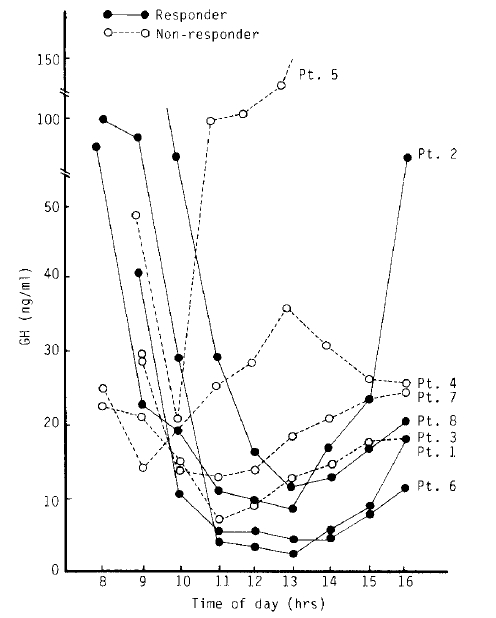
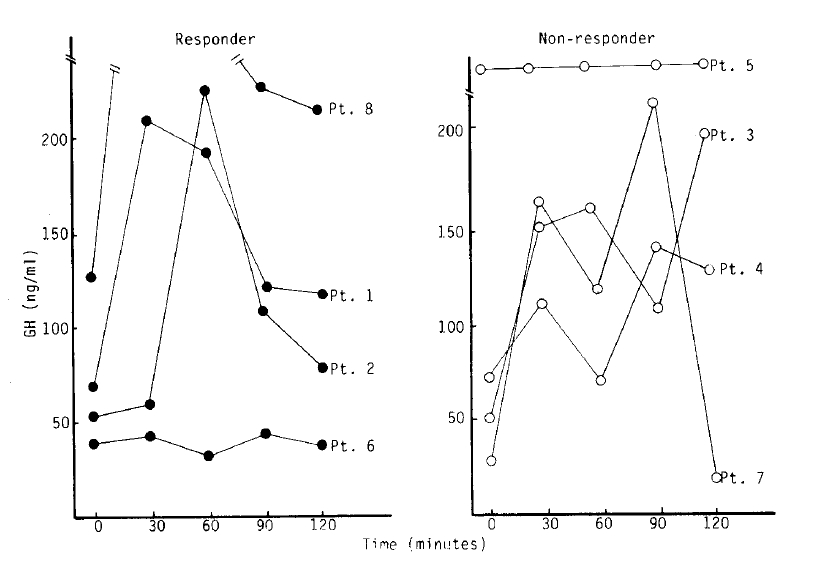
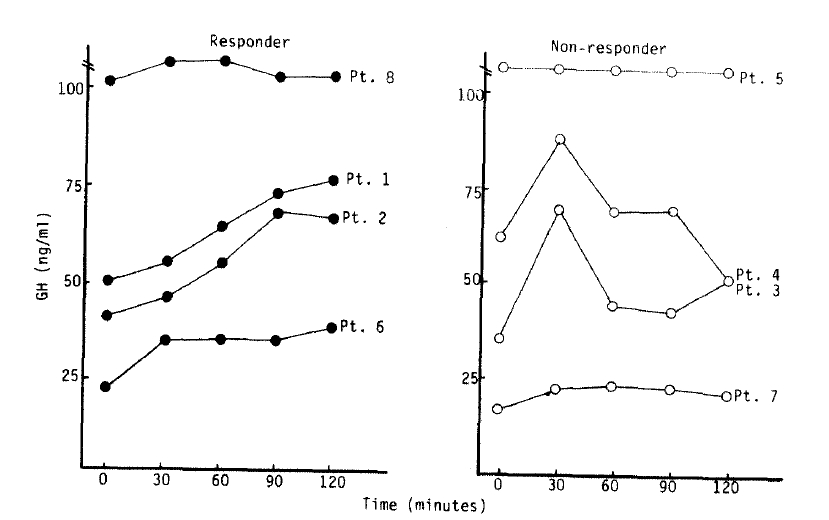
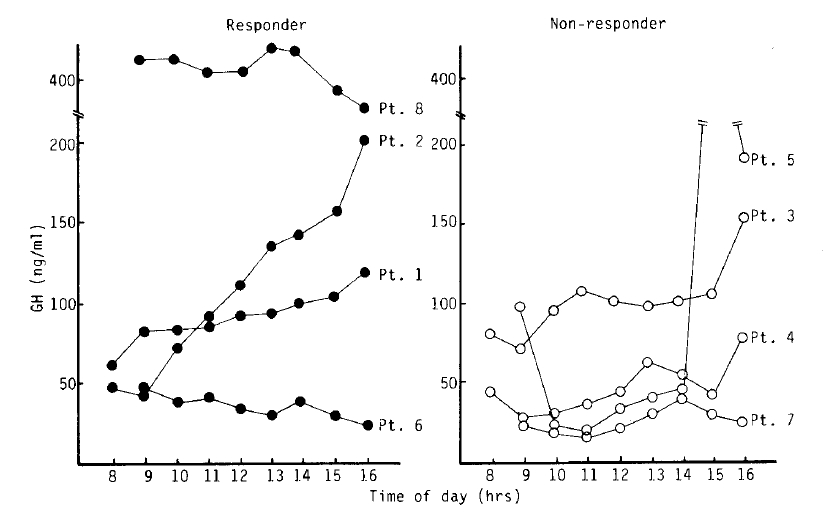
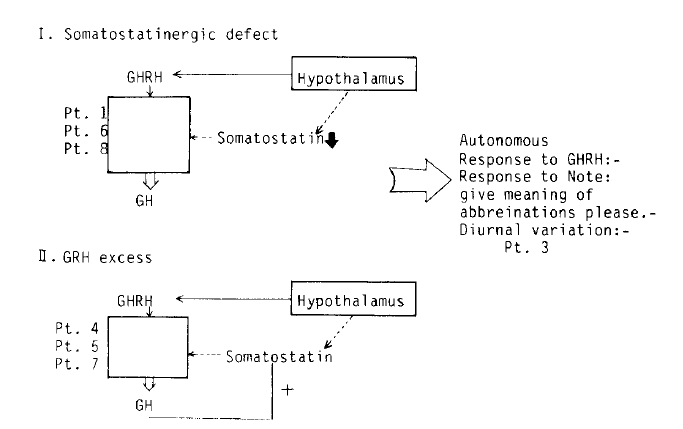
 PDF Links
PDF Links PubReader
PubReader ePub Link
ePub Link Full text via DOI
Full text via DOI Download Citation
Download Citation Print
Print





